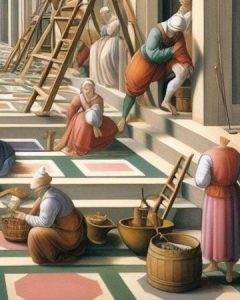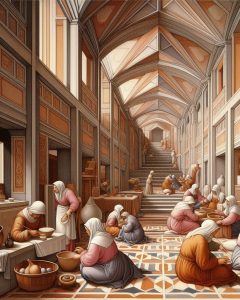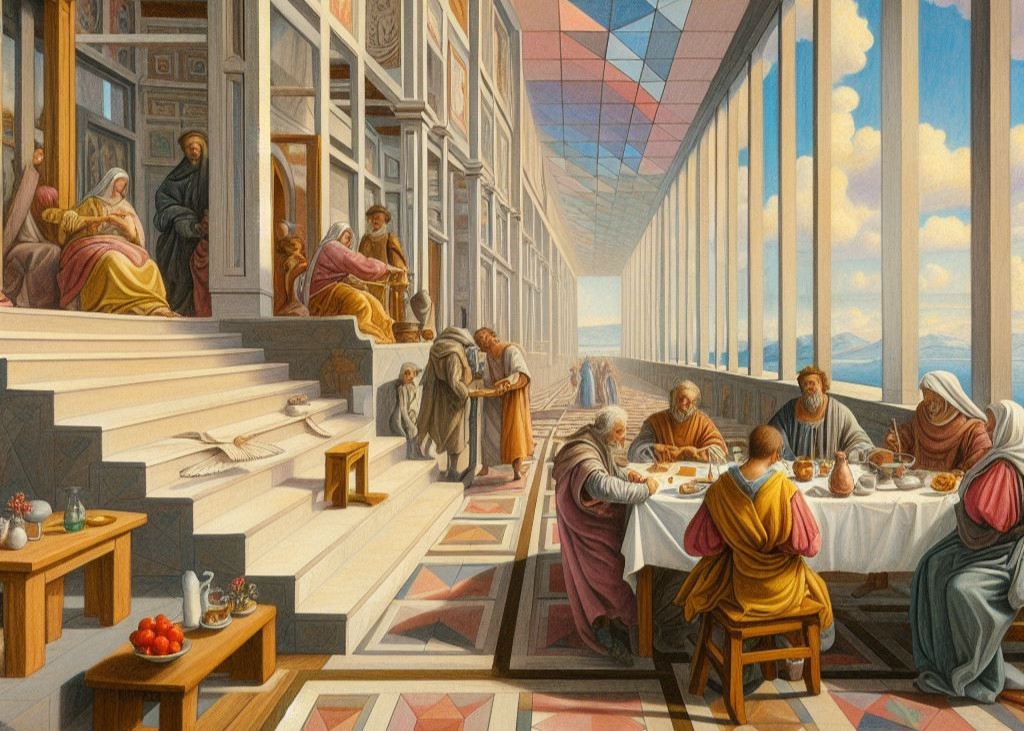Sometimes they are not enough; you need colors and shapes to enliven the words



 Poetry is an art that allows you to express your thoughts and feelings in a creative and personal way. Writing poetry, or simply having fun with words https://www.masterclass.com/articles/how-to-write-poetry, allows you to reflect on life and the world around you. Additionally, a poem can be a means of sharing your experiences and creating an emotional connection with a reader. If you like writing poetry, keep doing it and never stop, if you have never done it, start now, you will discover a completely unknown inner world of yours. Of course, as a beginner you can use some tricks. You could choose words – without any mutual connection, but referring to a thing, person or theme – writing them in the center of a page, one under the other, then integrating them with other words that will generate your poem. You could cut out some words from a newspaper page, assemble them randomly, add what is needed to give meaning and flow to your text and be amazed at the final result.
Poetry is an art that allows you to express your thoughts and feelings in a creative and personal way. Writing poetry, or simply having fun with words https://www.masterclass.com/articles/how-to-write-poetry, allows you to reflect on life and the world around you. Additionally, a poem can be a means of sharing your experiences and creating an emotional connection with a reader. If you like writing poetry, keep doing it and never stop, if you have never done it, start now, you will discover a completely unknown inner world of yours. Of course, as a beginner you can use some tricks. You could choose words – without any mutual connection, but referring to a thing, person or theme – writing them in the center of a page, one under the other, then integrating them with other words that will generate your poem. You could cut out some words from a newspaper page, assemble them randomly, add what is needed to give meaning and flow to your text and be amazed at the final result.



 His pictorial genre was mainly oil painting. Piero della Francesca, an Italian painter of the 15th century born in Borgo Sansepolcro around 1412, is the artist we have chosen to accompany the reading of some poems that you find included in this article. Known for his works in Urbino, Arezzo, Rimini and Sansepolcro, he received training from Domenico Veneziano, with whom he collaborated in the decoration of the Chapel of Santa Maria Novella in Florence. His oil painting, an excellent binder that hardens over time, used powdered pigments. But not only that, it allowed the artist to broaden the chromatic range and soften the nuances. Among his most famous works, we offer you the Madonna del Parto http://www.madonnadelparto.it/ and the series of frescoes on the History of the True Cross in the church of San Francesco in Arezzo https://www.discoverarezzo.com/experiences/the-legend-of-the-true-cross/. To develop what you think, you could refer to two Italian contemporary poets and let yourself go to the suggestion of some images that we have created for you using artificial intelligence.
His pictorial genre was mainly oil painting. Piero della Francesca, an Italian painter of the 15th century born in Borgo Sansepolcro around 1412, is the artist we have chosen to accompany the reading of some poems that you find included in this article. Known for his works in Urbino, Arezzo, Rimini and Sansepolcro, he received training from Domenico Veneziano, with whom he collaborated in the decoration of the Chapel of Santa Maria Novella in Florence. His oil painting, an excellent binder that hardens over time, used powdered pigments. But not only that, it allowed the artist to broaden the chromatic range and soften the nuances. Among his most famous works, we offer you the Madonna del Parto http://www.madonnadelparto.it/ and the series of frescoes on the History of the True Cross in the church of San Francesco in Arezzo https://www.discoverarezzo.com/experiences/the-legend-of-the-true-cross/. To develop what you think, you could refer to two Italian contemporary poets and let yourself go to the suggestion of some images that we have created for you using artificial intelligence.

 Born in Milan in 1912, Antonia Pozzi http://www.antoniapozzi.it/ was an Italian poet and writer whose creative synthesis combined nature and spirituality. Only beloved Lombardy could console her. To study and write, she found peace in the mountains where she also collected thousands of photographic shots. Her spirit, similar to the kind of mountain plants that find lifeblood on the edge of the abyss, was in conflict with her family environment. The use of essential and suggestive language also recurs in these poems of hers that we have chosen for you: THE TORRENT – Joy of singing like you, torrent; joy of laughing feeling in your mouth teeth as white as your riverbed; joy of being born only on a sunny morning among the violets of a pasture; of having forgotten the night and the bite of the ice. I DON’T KNOW – I think that your way of smiling is sweeter than the sun on this vase of already slightly withered flowers. I think that perhaps it is good that all the trees fall from me, that I am a deserted white square at your voice, that perhaps draws the avenues for the new garden. AMOR FATI – When from my darkness you overflow with a crash in a waterfall of blood, I will sail with a red sail through horrid silences to the craters of the promised light. LOVE IN THE DISTANCE – I remember that, when I was in my mother’s house, in the middle of the plain, I had a window that looked out onto the meadows; at the bottom, the wooded bank hid the Ticino and, even further down, there was a dark strip of hills. At the time I had only seen the sea once, but I retained a bitter nostalgia for it as a lover. Towards evening I stared at the horizon; I closed my eyes a little; I caressed the contours and the colors between my eyelashes: and the strip of hills flattened out, tremulous, blue: to me it seemed like the sea and I liked it more than the real sea.
Born in Milan in 1912, Antonia Pozzi http://www.antoniapozzi.it/ was an Italian poet and writer whose creative synthesis combined nature and spirituality. Only beloved Lombardy could console her. To study and write, she found peace in the mountains where she also collected thousands of photographic shots. Her spirit, similar to the kind of mountain plants that find lifeblood on the edge of the abyss, was in conflict with her family environment. The use of essential and suggestive language also recurs in these poems of hers that we have chosen for you: THE TORRENT – Joy of singing like you, torrent; joy of laughing feeling in your mouth teeth as white as your riverbed; joy of being born only on a sunny morning among the violets of a pasture; of having forgotten the night and the bite of the ice. I DON’T KNOW – I think that your way of smiling is sweeter than the sun on this vase of already slightly withered flowers. I think that perhaps it is good that all the trees fall from me, that I am a deserted white square at your voice, that perhaps draws the avenues for the new garden. AMOR FATI – When from my darkness you overflow with a crash in a waterfall of blood, I will sail with a red sail through horrid silences to the craters of the promised light. LOVE IN THE DISTANCE – I remember that, when I was in my mother’s house, in the middle of the plain, I had a window that looked out onto the meadows; at the bottom, the wooded bank hid the Ticino and, even further down, there was a dark strip of hills. At the time I had only seen the sea once, but I retained a bitter nostalgia for it as a lover. Towards evening I stared at the horizon; I closed my eyes a little; I caressed the contours and the colors between my eyelashes: and the strip of hills flattened out, tremulous, blue: to me it seemed like the sea and I liked it more than the real sea.

 Among his best-known works are “Ora serrata retinae” and “Geologia di un padre”. Valerio Magrelli https://www.einaudi.it/autori/valerio-magrelli/, Italian poet, writer and literary critic born in Rome in 1957, has developed a poetic genre characterized by an ironic and surreal language that explores the themes of identity, memory and history. PHENOMENA – Here I am without landscape, pears, apples, seasons, sky, nothing, just furnishings, an artificially created countryside. But already as a child, for fun, I would spread a blanket in the room, over piles of paper, and it was a panorama, a body of mountains. Something of all this remains, now that I write in bed, that I lay down the earth. DISPENSA – Dispensa has never been given a more appropriate name. Heart of food placed in the heart of the home like the immobile engine of cosmologies. Tabernacle food and secret place. FEELING BAD – Feeling bad seems to mean that the pain prevents you from listening to yourself. The disease takes his body far away, too distant to be heard. ELEGY – If all that grows and burns is embers, love is the vision of the pyre. Think of summer, which is born bleeding into a smiling hemorrhage of light. What is dear to you dies, what dies is dear to you, if something is dear to you, it is because it dies. And here is the corollary: What is dear to you is only his death. It’s evening, in my children’s room. Lying next to them, I listen to them chirp. A forest in the dark. They place the warm and living weight of the voice on my branches, a trembling flight-weight. Or must I believe that they are only the incandescent tips of a half-extinguished, collapsed, half-cold fire, of an already black and silent ember, already silent, half dead?
Among his best-known works are “Ora serrata retinae” and “Geologia di un padre”. Valerio Magrelli https://www.einaudi.it/autori/valerio-magrelli/, Italian poet, writer and literary critic born in Rome in 1957, has developed a poetic genre characterized by an ironic and surreal language that explores the themes of identity, memory and history. PHENOMENA – Here I am without landscape, pears, apples, seasons, sky, nothing, just furnishings, an artificially created countryside. But already as a child, for fun, I would spread a blanket in the room, over piles of paper, and it was a panorama, a body of mountains. Something of all this remains, now that I write in bed, that I lay down the earth. DISPENSA – Dispensa has never been given a more appropriate name. Heart of food placed in the heart of the home like the immobile engine of cosmologies. Tabernacle food and secret place. FEELING BAD – Feeling bad seems to mean that the pain prevents you from listening to yourself. The disease takes his body far away, too distant to be heard. ELEGY – If all that grows and burns is embers, love is the vision of the pyre. Think of summer, which is born bleeding into a smiling hemorrhage of light. What is dear to you dies, what dies is dear to you, if something is dear to you, it is because it dies. And here is the corollary: What is dear to you is only his death. It’s evening, in my children’s room. Lying next to them, I listen to them chirp. A forest in the dark. They place the warm and living weight of the voice on my branches, a trembling flight-weight. Or must I believe that they are only the incandescent tips of a half-extinguished, collapsed, half-cold fire, of an already black and silent ember, already silent, half dead?

 If you want to know other writers, you can type http://meetingbenches.com/category/library/, while for poets around the world http://meetingbenches.com/category/poetry/. The sole purpose of this site is to spread the knowledge of these artists and that other people enjoy their works. The property of the images that appear in this blog correspond to their authors.
If you want to know other writers, you can type http://meetingbenches.com/category/library/, while for poets around the world http://meetingbenches.com/category/poetry/. The sole purpose of this site is to spread the knowledge of these artists and that other people enjoy their works. The property of the images that appear in this blog correspond to their authors.





